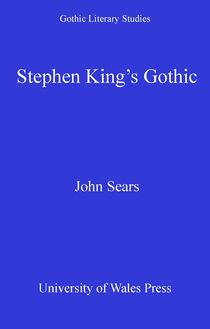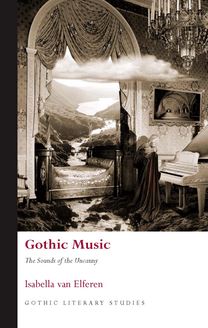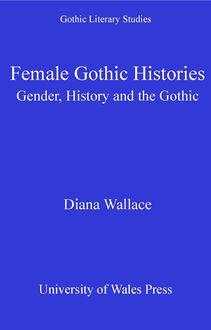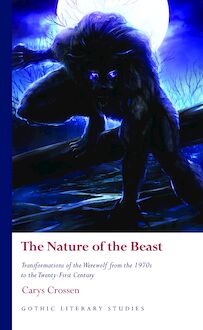-
 Univers
Univers
-
 Ebooks
Ebooks
-
 Livres audio
Livres audio
-
 Presse
Presse
-
 Podcasts
Podcasts
-
 BD
BD
-
 Documents
Documents
-
- Cours
- Révisions
- Ressources pédagogiques
- Sciences de l’éducation
- Manuels scolaires
- Langues
- Travaux de classe
- Annales de BEP
- Etudes supérieures
- Maternelle et primaire
- Fiches de lecture
- Orientation scolaire
- Méthodologie
- Corrigés de devoir
- Annales d’examens et concours
- Annales du bac
- Annales du brevet
- Rapports de stage
La lecture à portée de main
Vous pourrez modifier la taille du texte de cet ouvrage
Découvre YouScribe en t'inscrivant gratuitement
Je m'inscrisDécouvre YouScribe en t'inscrivant gratuitement
Je m'inscrisEn savoir plus
Vous pourrez modifier la taille du texte de cet ouvrage
En savoir plus

Description
Penny Dreadfuls and the Gothic breaks new ground in uncovering penny titles which have been hitherto largely neglected from literary discourse revealing the cultural, social and literary significance of these working-class texts. The present volume is a reappraisal of penny dreadfuls, demonstrating their cruciality in both our understanding of working-class Victorian Literature and the Gothic mode. This edited collection of essays provides new insights into the fields of Victorian literature, popular culture and Gothic fiction more broadly; it is divided into three sections, whose titles replicate the dual titles offered by penny publications during the nineteenth century. Sections one and two consist of three chapters, while section three consists of four essays, all of which intertwine to create an in-depth and intertextual exposition of Victorian society, literature, and gothic representations.
Acknowledgments
Notes on Contributors
List of Figures and Illustrations
1. Introduction:
Dreadful Beginnings
Dr Nicole C. Dittmer and Sophie Raine
Section One: The Progression of Pennys; or, Adaptations and Legacies of the Dreadful
2. Penny Pinching:
Reassessing the Gothic canon through nineteenth-century reprinting
Hannah-Freya Blake and Marie Léger-St-Jean
3. “As long as you are industrious, you will get on very well”:
adapting The String of Pearls’ economies of horror
Brontë Schiltz
4. “Your lot is wretched, old man”:
Anxieties of Industry, Empire and England in
George Reynolds’s Wagner, the Wehr-Wolf
Dr Hannah Priest
Section Two: Victorian Medical Sciences and Penny fiction; or, Dreadful Discourses of the Gothic
5. ‘Embalmed pestilence’, ‘intoxicating poisons’:
Rhetoric of contamination, contagion, and the Gothic
marginalisation of penny dreadfuls by their contemporary critics
Manon Burz-Labrande
6. “A Tale of the Plague”:
anti-medical sentiment and epidemic disease
in early Victorian popular Gothic fiction
Joseph Crawford
7. “Mistress of the broomstick”:
Biology, Ecosemiotics, and Monstrous Women
in Wizard’s The Wild Witch of the Heath; or the Demon of the Glen
Dr Nicole C. Dittmer
Section Three: Mode, Genre, and Style; or, Gothic Storytelling and Ideologies
8. A Ventriloquist and a Highwayman Walk into an Inn...
Early Penny Bloods and the Politics of Humour
in Jack Rann and Valentine Vaux
Celine Frohn
9. Gothic Ideology and Religious Politics
in James Malcolm Rymer’s Penny Fiction
Dr Rebecca Nesvet
10. “Muddling about among the dead”:
found manuscripts and metafictional storytelling
in James Malcolm Rymer’s Newgate: A Romance
Sophie Raine
List of Referenced Penny Titles
Bibliography
Index
Sujets
Informations
| Publié par | University of Wales Press |
| Date de parution | 15 février 2023 |
| Nombre de lectures | 0 |
| EAN13 | 9781786839725 |
| Langue | English |
Informations légales : prix de location à la page 0,4700€. Cette information est donnée uniquement à titre indicatif conformément à la législation en vigueur.
Extrait
PENNY DREADFULS AND THE GOTHIC
SERIES PREFACE
Gothic Literary Studies is dedicated to publishing groundbreaking scholarship on Gothic in literature and film. The Gothic, which has been subjected to a variety of critical and theoretical approaches, is a form which plays an important role in our understanding of literary, intellectual and cultural histories. The series seeks to promote challenging and innovative approaches to Gothic which question any aspect of the Gothic tradition or perceived critical orthodoxy. Volumes in the series explore how issues such as gender, religion, nation and sexuality have shaped our view of the Gothic tradition. Both academically rigorous and informed by the latest developments in critical theory, the series provides an important focus for scholarly developments in Gothic studies, literary studies, cultural studies and critical theory. The series will be of interest to students of all levels and to scholars and teachers of the Gothic and literary and cultural histories.
SERIES EDITORS
Andrew Smith, University of Sheffield
Benjamin F. Fisher, University of Mississippi
EDITORIAL BOARD
Kent Ljungquist, Worcester Polytechnic Institute Massachusetts
Richard Fusco, St Joseph’s University, Philadelphia
David Punter, University of Bristol
Chris Baldick, University of London
Angela Wright, University of Sheffield
Jerrold E. Hogle, University of Arizona
For all titles in the Gothic Literary Studies series visit www.uwp.co.uk
Penny Dreadfuls and the Gothic
Investigations of Pernicious Tales of Terror
edited by
Nicole C. Dittmer and Sophie Raine
© The Contributors, 2023
All rights reserved. No part of this book may be reproduced in any material form (including photocopying or storing it in any medium by electronic means and whether or not transiently or incidentally to some other use of this publication) without the written permission of the copyright owner except in accordance with the provisions of the Copyright, Designs and Patents Act. Applications for the copyright owner’s written permission to reproduce any part of this publication should be addressed to the University of Wales Press, University Registry, King Edward VII Avenue, Cardiff CF10 3NS.
www.uwp.co.uk
British Library Cataloguing-in-Publication Data
A catalogue record for this book is available from the British Library.
ISBN 978-1-78683-970-1
eISBN 978-1-78683-972-5
The rights of The Contributors to be identified as authors of this work have been asserted in accordance with sections 77 and 79 of the Copyright, Designs and Patents Act 1988.
The publisher has no responsibility for the persistence or accuracy of URLs for any external or third-party internet websites referred to in this book, and does not guarantee that any content on such websites is, or will remain, accurate or appropriate.
C ONTENTS
Acknowledgements
Notes on Contributors
List of Figures and Illustrations
1 Introduction: Dreadful Beginnings Nicole C. Dittmer and Sophie Raine
Section One: The Progression of Pennys; or, Adaptations and Legacies of the Dreadful
2 Penny Pinching: Reassessing the Gothic Canon through Nineteenth-century Reprinting Hannah-Freya Blake and Marie Léger-St-Jean
3 ‘As long as you are industrious, you will get on very well’: Adapting The String of Pearls ’s Economies of Horror Brontë Schiltz
4 ‘Your lot is wretched, old man’: Anxieties of Industry, Empire, and England in George Reynolds’s Wagner, the Wehr-Wolf Hannah Priest
Section Two: Victorian Medical Sciences and Penny Fiction; or, Dreadful Discourses of the Gothic
5 ‘Embalmed pestilence’, ‘intoxicating poisons’: Rhetoric of Contamination, Contagion, and the Gothic Marginalisation of Penny Dreadfuls by their Contemporary Critics Manon Burz-Labrande
6 ‘A Tale of the Plague’: Anti-medical Sentiment and Epidemic Disease in Early Victorian Popular Gothic Fiction Joseph Crawford
7 ‘Mistress of the Broomstick’: Biology, Ecosemiotics and Monstrous Women in Wizard’s The Wild Witch of the Heath; or The Demon of the Glen Nicole C. Dittmer
Section Three: Mode, Genre, and Style; or, Gothic Storytelling and Ideologies
8 A Highwayman and a Ventriloquist Walk into an Inn … Early Penny Romances and the Politics of Humour in Jack Rann and Valentine Vaux Celine Frohn
9 Gothic Ideology and Religious Politics in James Malcolm Rymer’s Penny Fiction Rebecca Nesvet
10 ‘Muddling about among the dead’: Found Manuscripts and Metafictional Storytelling in James Malcolm Rymer’s Newgate: A Romance Sophie Raine
List of Referenced Penny Titles
Bibliography
Notes
A CKNOWLEDGEMENTS
This edited collection is a celebration of the early to mid-Victorian penny serialisations and all of the inquisitive Gothicists who seek to explore and analyse the darker side of all but forgotten literature.
We would like to thank all of the contributors to this collection whose fresh and thoughtful researches signify a revival of these serialisations.
Finally, we would like to offer a special thank you to Chloé Germaine Buckley, without whom this collection might have never spawned from imagination to publication.
N OTES ON C ONTRIBUTORS
Hannah-Freya Blake is a PhD candidate at Leeds Trinity University, studying the points at which horror and gender intersect to satirise societal norms. Her contribution to the forthcoming Speaking Picture, Silent Text edited by A. Alyal explores voyeurism in The Monk and The Devil’s Elixir in a chapter titled, ‘Ekphrasis and Ecstasy: The Visual Pleasure of Portraits in Lewis and Hoffmann’. A published poet and writer, her academic studies and creative projects align in her upcoming queer-Gothic novella, Cake Craft .
Manon Burz-Labrande is a doctoral researcher and lecturer at the University of Vienna, Austria. Specialising in Victorian popular literature and culture, her PhD focuses on the exploration of the concept of circulation in and of the penny bloods and penny dreadfuls, through a literary and cultural analysis of their literary content, the discourses they triggered in nineteenth-century criticism, their place in the Victorian literary landscape and their diachronic circulation. She has written articles and reviews for Victorian Popular Fictions Journal , Polysèmes , Revenant Journal and Wilkie Collins Journal , as well as entries for the Palgrave Encyclopedia of Victorian Women’s Writing (ed. Lesa Scholl). She also co-edited the Short Fiction in Theory & Practice special issue ‘More than Meets the Ear: Sound and Short Fiction’ (with Sylvia Mieszkowski and Harald Freidl), and is the editor of the collection Spectral Sounds: Unquiet Tales of Acoustic Weird (British Library, 2022).
Joseph Crawford is a Senior Lecturer in English Literature at the University of Exeter. His published works include Raising Milton’s Ghost (2011), Gothic Fiction and the Invention of Terrorism (2013), The Twilight of the Gothic (2014), and Inspiration and Insanity in British Poetry, 1825–55 (2019). His current research deals with medical cultures in the early Victorian period.
Nicole C. Dittmer , PhD, is a Lecturer of Victorian Gothic Studies at The College of New Jersey, Proofreader and editorial board member at the Studies in Gothic Fiction , and advisory board member of Ecocritical Theory and Practice for Rowman & Littlefield’s imprint, Lexington Books. Some of her works include ‘Malignancy of Goneril: Nature’s Powerful Warrior’, published in Global Perspectives on Eco-Aesthetics and Eco-Ethics: A Green Critique (2020); the monograph, Monstrous Women and Ecofeminism in the Victorian Gothic, 1837–1871 (2022); forthcoming British Library collection Penny Bloods: Gothic Tales of Dangerous Women (May 2023); the contribution ‘Victorianism and Ecofeminist Literature’ for The Routledge Handbook of Ecofeminism and Literature (2022) edited by Douglas Vakoch; and a chapter, ‘“the terror of the rustics”; or, Witches and Werewolves: Lunar and ecoGothic Monstrosities in Catherine Crowe’s “A Story of a Weir-Wolf ” (1846) and The Nightside of Nature (1847)’ for Simon Bacon and Elana Gomel’s forthcoming Palgrave Macmillan collection, Lunar Gothic (2024). She received her PhD in Gothic Studies from Manchester Metropolitan University where she researched penny publications, medical humanities, and ecocriticism in the nineteenth-century. Website: www.nicoledittmer.com . ORCID: https://orcid.org/0000-0001-6626-2888 .
Celine Frohn is a PhD candidate at the University of Sheffield. Her thesis, ‘Strange laughter: early penny bloods and humour’ investigates the generic dimensions of penny bloods published between 1838 and 1850. She is also the founder and general editor of Nyx Publishing, an independent publisher of queer speculative fiction.
Marie Léger-St-Jean is a freelancer, a digital humanist and a proud independent scholar working on nineteenth-century transnational transmedia mass culture. She is the founder of and mastermind behind Price One Penny , a bibliographical and biographical database about the countless publishers and authors involved in the production of cheap literature in London from the 1830s to the 1850s. Her single-author and co-authored work appears in collections – Media and Print Culture Consumption in Nineteenth-Century Britain (2016), edited by P. R. Rooney and A. Gasperini, Edward Lloyd and his World (2019), edited by R. McWilliam and S. Lill, and Reynolds Revisited (forthcoming) edited by M. L. Shannon and J. Conary – and in special issues of Amerikastudien/American Studies on digital humanities (2018) and Victorian Popular Fictions Journal on piracy (forthcoming).
Rebecca Nesvet has written about James Malcolm Rymer and Victorian penny fiction for Victorians Institute Journal , Nineteenth Century Studies , Victorian Popular Fictions Journal , Scholarly Editing , Notes and Queries , Victorians Institute Journal , Victorian Network and the BRANCH Collective timeline. Her edition of Rymer’s A Mystery in Scarlet is being published by
-
 Univers
Univers
-
 Ebooks
Ebooks
-
 Livres audio
Livres audio
-
 Presse
Presse
-
 Podcasts
Podcasts
-
 BD
BD
-
 Documents
Documents
-
Jeunesse
-
Littérature
-
Ressources professionnelles
-
Santé et bien-être
-
Savoirs
-
Education
-
Loisirs et hobbies
-
Art, musique et cinéma
-
Actualité et débat de société
-
Jeunesse
-
Littérature
-
Ressources professionnelles
-
Santé et bien-être
-
Savoirs
-
Education
-
Loisirs et hobbies
-
Art, musique et cinéma
-
Actualité et débat de société
-
Actualités
-
Lifestyle
-
Presse jeunesse
-
Presse professionnelle
-
Pratique
-
Presse sportive
-
Presse internationale
-
Culture & Médias
-
Action et Aventures
-
Science-fiction et Fantasy
-
Société
-
Jeunesse
-
Littérature
-
Ressources professionnelles
-
Santé et bien-être
-
Savoirs
-
Education
-
Loisirs et hobbies
-
Art, musique et cinéma
-
Actualité et débat de société
- Cours
- Révisions
- Ressources pédagogiques
- Sciences de l’éducation
- Manuels scolaires
- Langues
- Travaux de classe
- Annales de BEP
- Etudes supérieures
- Maternelle et primaire
- Fiches de lecture
- Orientation scolaire
- Méthodologie
- Corrigés de devoir
- Annales d’examens et concours
- Annales du bac
- Annales du brevet
- Rapports de stage




















